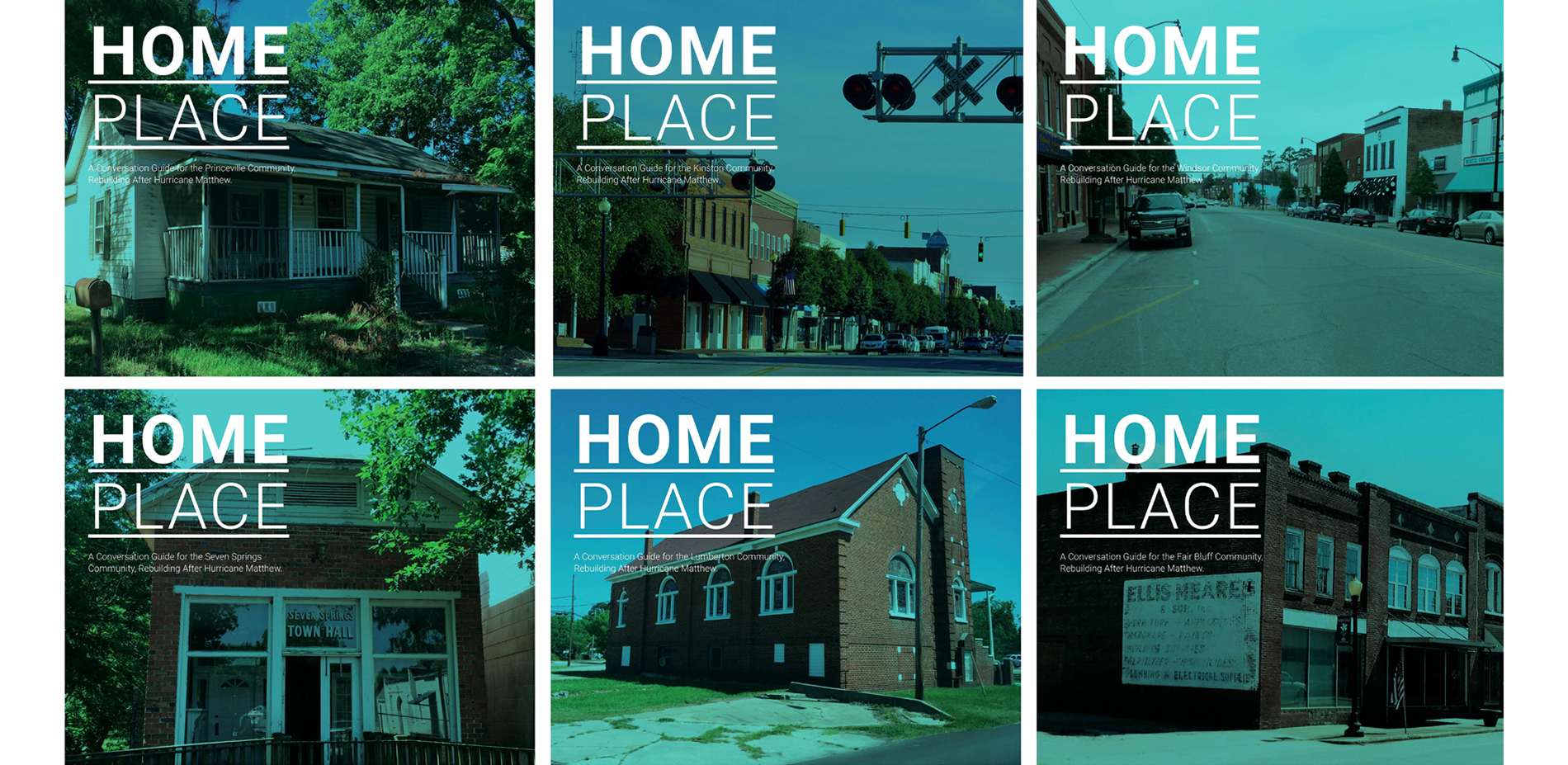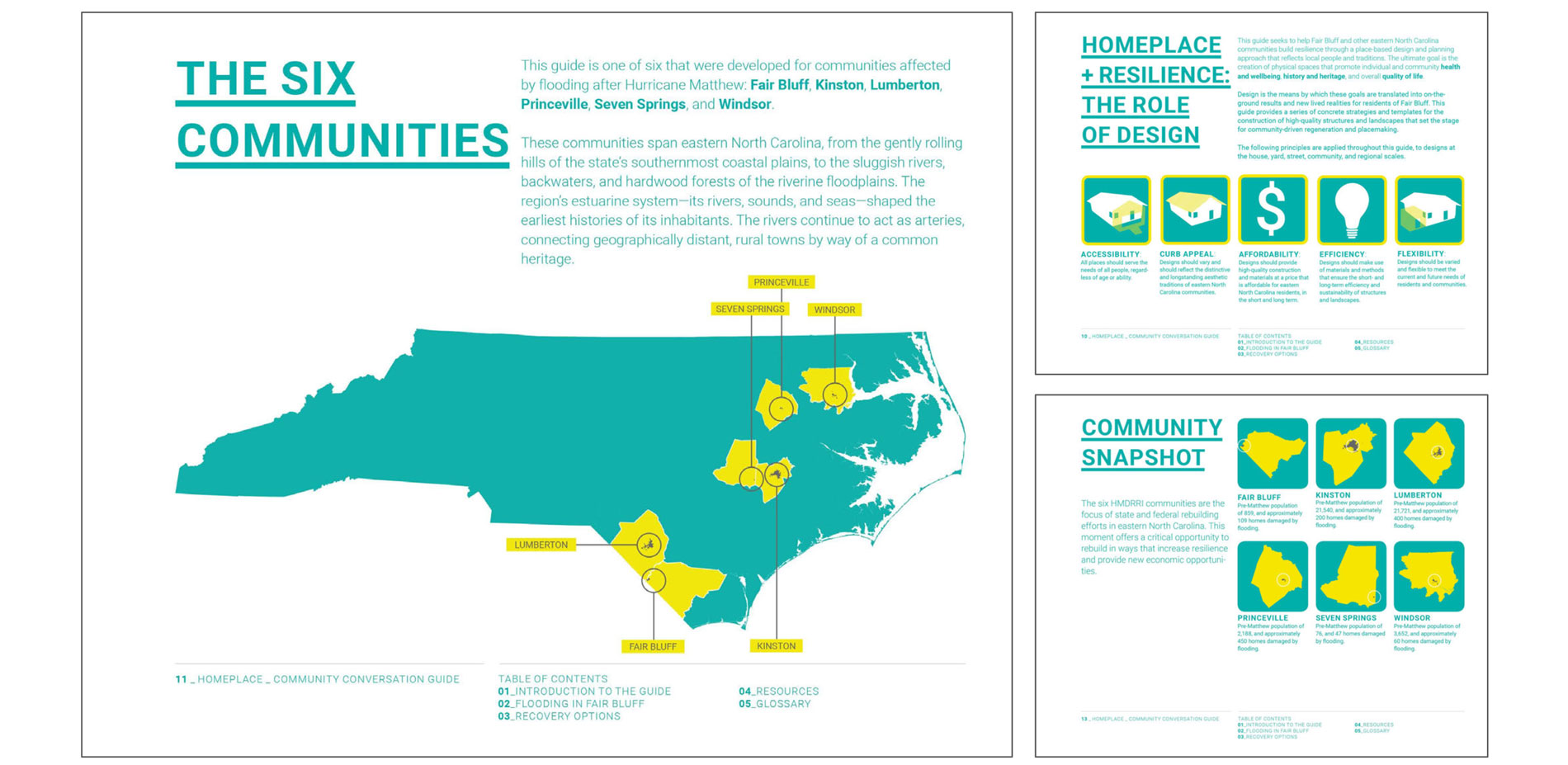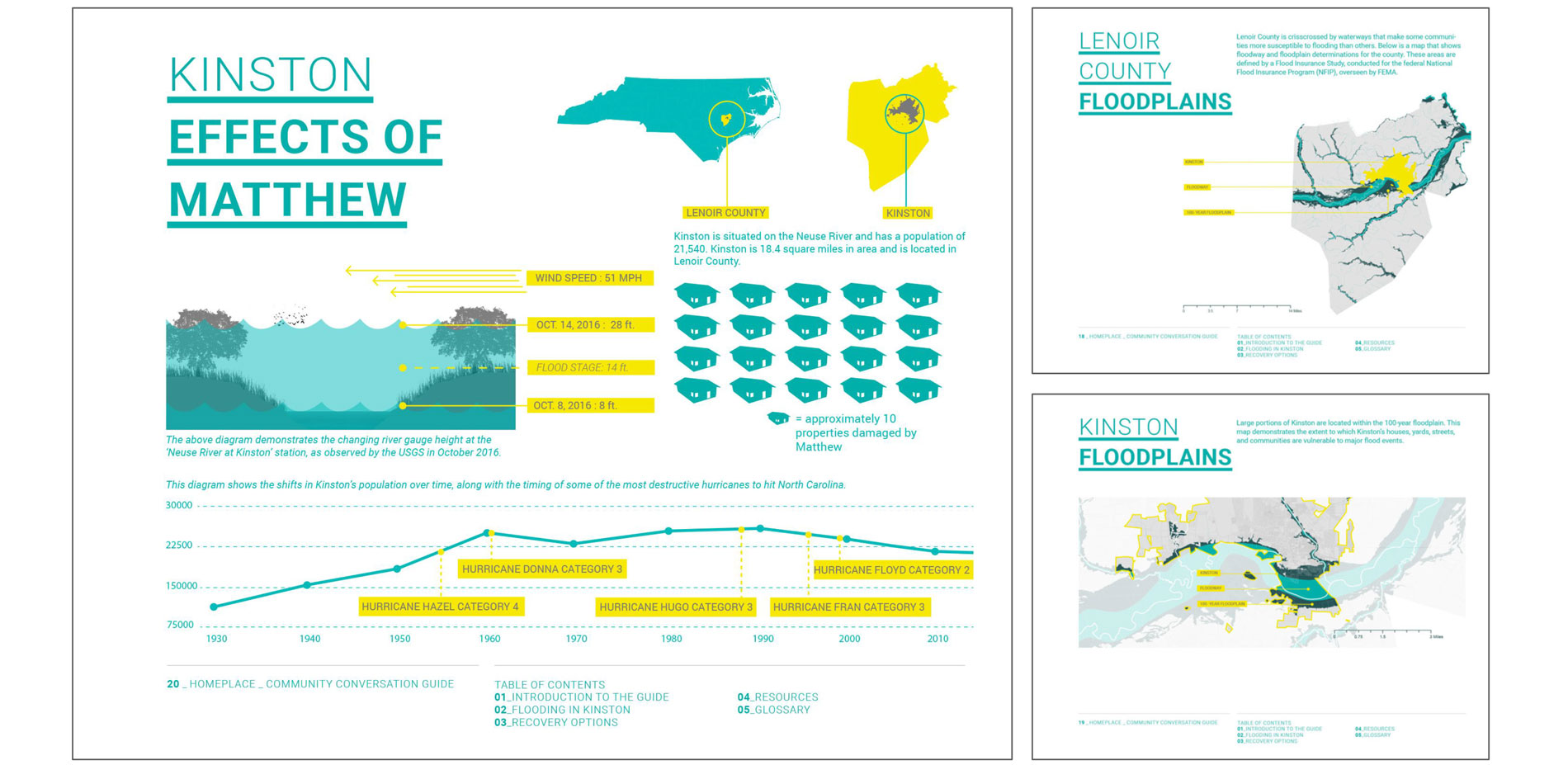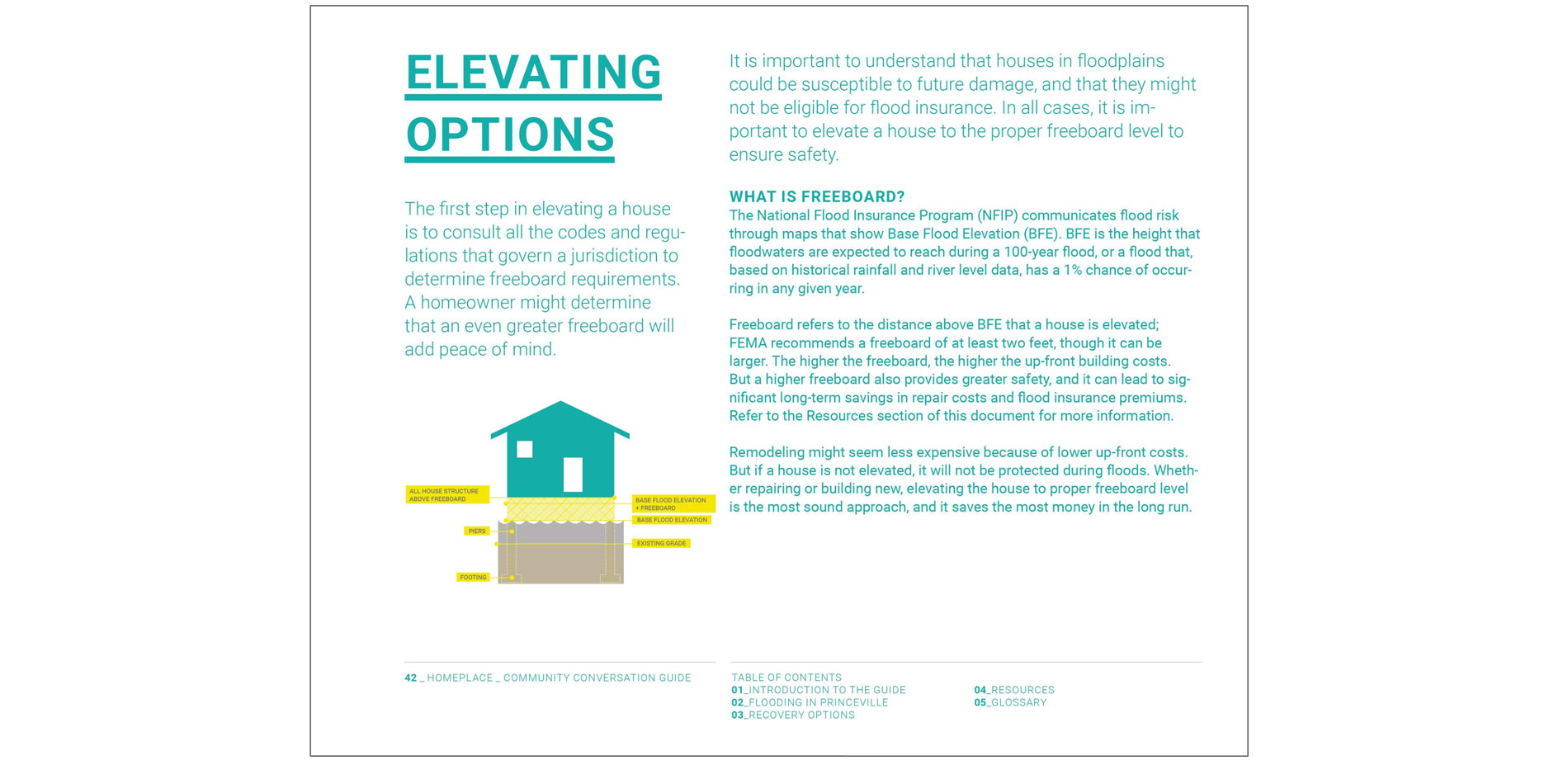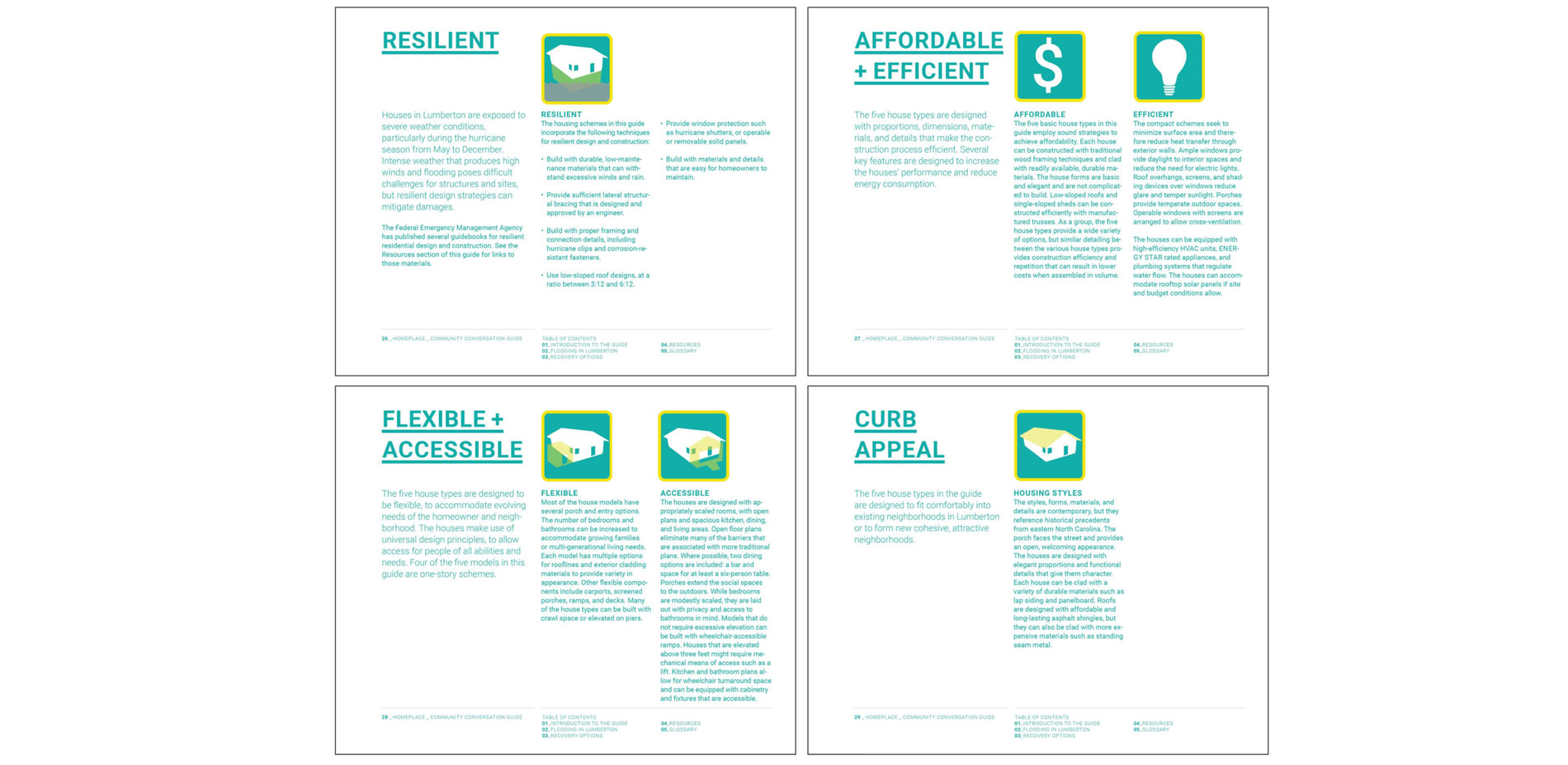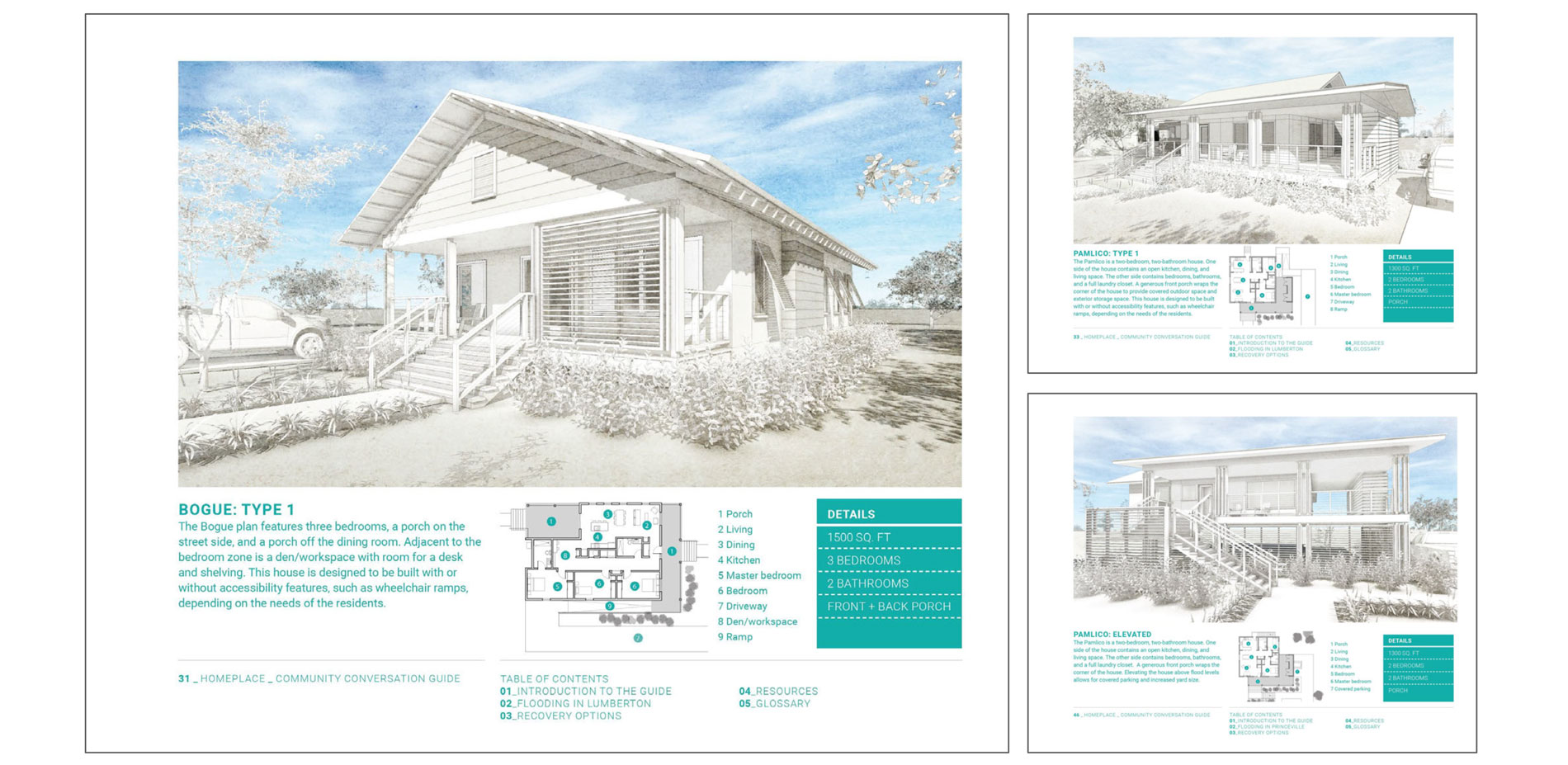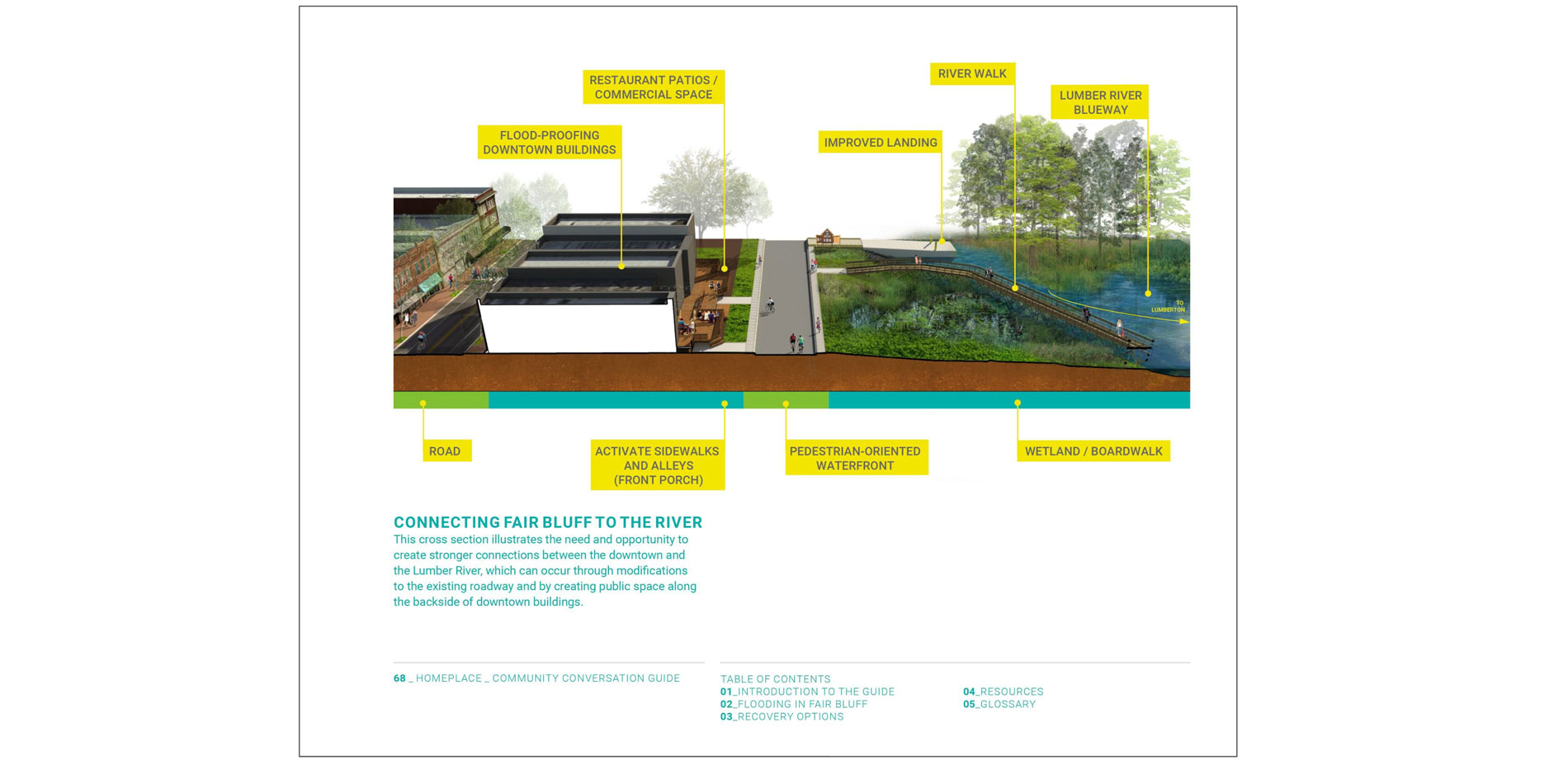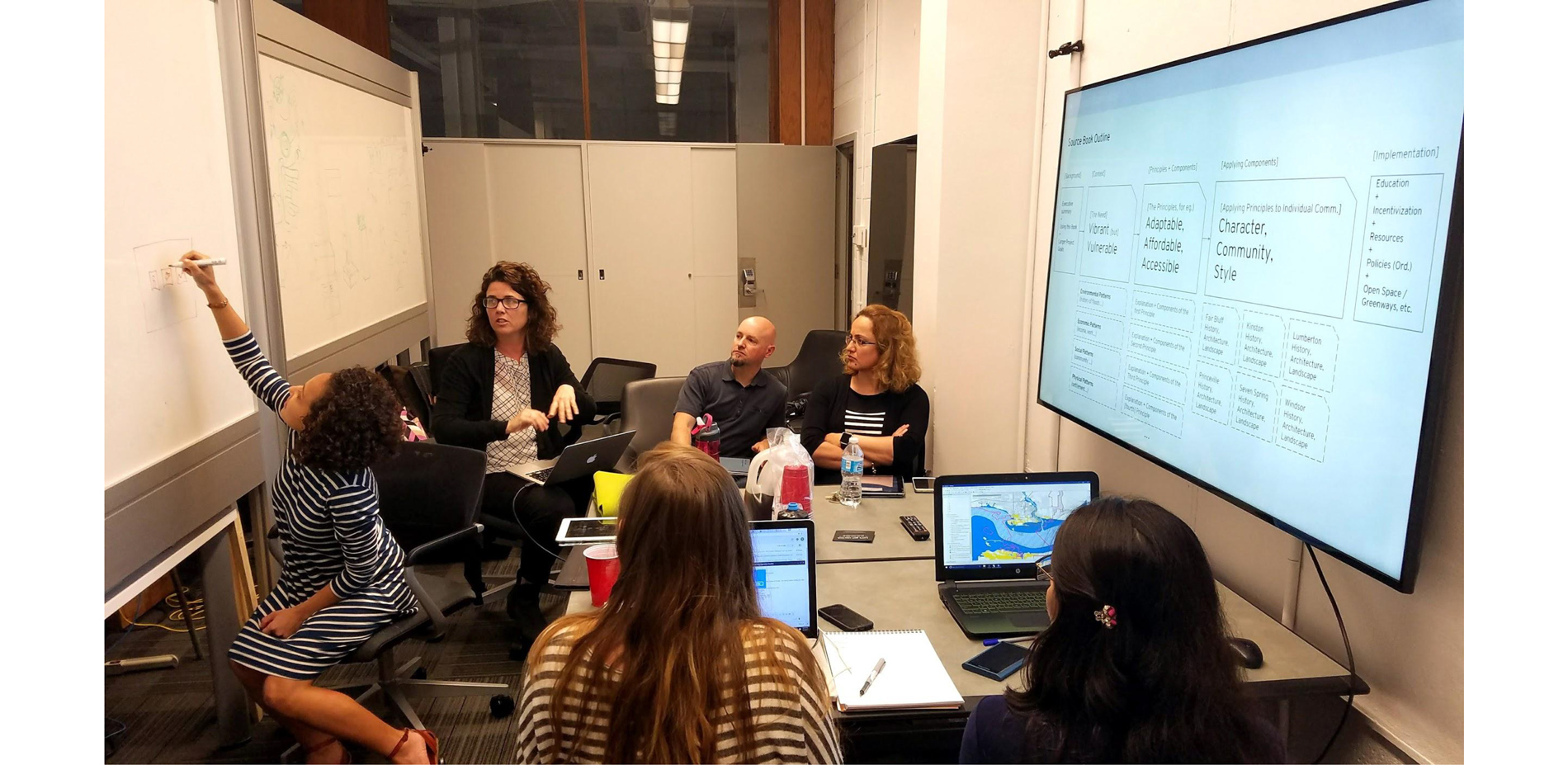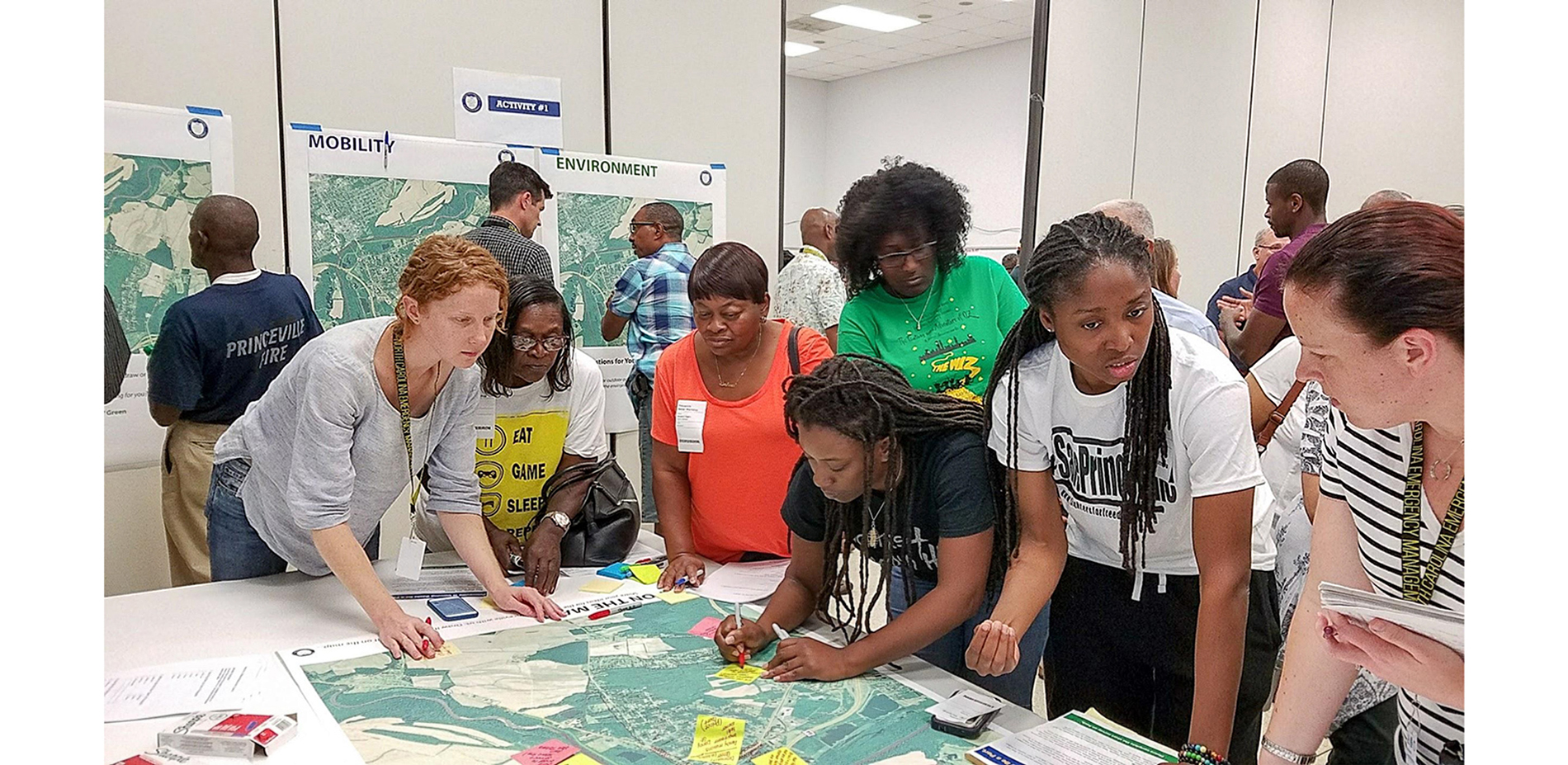Homeplace: Conversation Guides for Six Communities, Rebuilding After Hurricane Matthew
HONOR AWARD
Communications
Multiple communities, NC, USA | NC State University Coastal Dynamics Design Lab | Client: Hurricane Matthew Disaster Recovery and Resilience Initiative (HMDRRI)
What are often very difficult concepts to explain is here very clearly expressed... The graphic clarity is wonderful.
- 2018 Awards Jury
PROJECT CREDITS
Landscape Architect
- Coastal Dynamics Design Lab, North Carolina State University College of Design
- PUBLICATION DESIGN TEAM:
- Andrew Fox, ASLA, PLA (Principal Investigator)
- Tania Allen (Co-Principal Investigator)
- Kofi Boone, ASLA (Co-Principal Investigator)
- Charles A. Flink II, FASLA, PLA
- David Hill, AIA (Co-Principal Investigator)
- Robby Layton, PhD, FASLA, PLA, CPRP
- Celen Pasalar, PhD (Co-Principal Investigator)
- GRADUATE ASSISTANTS:
- Ezgi Balkanay
- Danielle Chelles
- Yu Chun Chiu
- Sharna Chowdhury
- Stephanie Heimstead
- Austin Marshall
- Lindsey Naylor
- James Popin
- Adam Walters
- CONSULTANTS:
- Design Concepts CLA, Inc.
- Greenways, Inc.
- INSTITUTIONAL PARTNERS:
- NC State University Department of Landscape Architecture
- NC State University Department of Art + Design
- NC State University School of Architecture
- University of North Carolina at Chapel Hill Coastal Resilience Center: A U.S. Department of Homeland Security Center of Excellence
- University of North Carolina at Chapel Hill Department of City and Regional Planning
- COMMUNITY PARTNERS:
- Town of Fair Bluff, North Carolina
- City of Kinston, North Carolina
- City of Lumberton, North Carolina
- Town of Princeville, North Carolina
- Town of Seven Springs, North Carolina
- Town of Windsor, North Carolina
- PROJECT GRANTOR:
- University of North Carolina at Chapel Hill/North Carolina Policy Collaboratory
PROJECT STATEMENT
Although there is public awareness of information describing the effects of climate change, gaps remain in how information is communicated to enable impactful decision-making. There aren't enough human-stories (relatable to everyday people) grounding climate change strategies, and there is a dearth of digital tools reflecting contemporary engagement with complex data.
Homeplace: Conversation Guides for Six Communities, Rebuilding from Hurricane Matthew were designed to address these communication gaps. Although the guides include data and ecological context, they are derived from the vernacular interface between house and landscape that defines home. The guides address the human ecology of the region—including the realities of living with and responding to floods—and feature strategies that reflect the lived experiences of people in the landscape. Additionally, Homeplace was designed to not only function as a physical document to initiate critical dialogue with affected communities—it responds to the realities of low-resource rural communities by being formatted to view and share electronically. In future phases of recovery planning, Homeplace offers a communication infrastructure that can be modified, updated and distributed using multiple platforms.
PROJECT NARRATIVE
On October 8, 2016, Hurricane Matthew stalled over eastern North Carolina, bringing with it record-setting rainfall. The resulting floods were catastrophic, leaving communities across the state's coastal plain region devastated. The storm ranks as the third most destructive disaster in the state's history, claiming 31 lives, flooding an estimated 100,000 structures, and exceeding $1.5 billion in damages.
Rebuilding in the aftermath of disaster is emotional, stressful, and complicated. Local, state and federal policies and procedures are confusing and overwhelming for survivors as they attempt to recover from the storm trauma while simultaneously navigating dense bureaucratic language, obscure acronyms, and highly technical documents in an attempt to piece back together their lives and communities.
Purpose
In the wake of the storm, the Homeplace conversation guides were developed to assist flood survivors decode and understand the complex information associated with recovery and resiliency building efforts. The purpose of the Homeplace suite of communication tools is to provide hard-hit communities with easy-to-understand technical assistance addressing typical post-disaster issues. Working within a larger, state-led recovery framework, the processes involved with the development and delivery of rebuilding programs enable dialogue with residents, community officials, and others. Homeplace supports these efforts by providing residents with a menu of high-quality, community-specific designs and strategies at multiple scales, resulting in a coordinated post-disaster rebuilding effort that strengthens communities in the long run. It offers strategies for application from household to community scales, along with consideration for broader regional infrastructures, development patterns, and population trends. The ultimate goal is to build the local capacity of North Carolina's flood-prone communities, providing them with design, planning, and policy strategies and tools to promote the long-term function, health, and vitality of their residents and neighborhoods. The recommendations in each of the six community-specific guides are currently being woven into each participating community's recovery plans, allowing for the integration of informed resident and stakeholder input into a more operational set of actions uniquely tailored to each community.
Audience + Approach
The voice, content, and design of Homeplace were strategically developed to speak to those individuals directly affected by the floods. Seen through the lens of the lay public, the guide is designed to facilitate community discussion between residents, designers, community planners and government officials. The approach considers the survivors' point-of-view—residents with a variety of previous exposure to the complexities involved with deciding when, how and where to re-build. Additionally, emphasis is placed on the principles and potential trade-offs of why a homeowner might decide to either: 1) elevate and remain in place, or 2) relocate their home. Homeplace explains and illustrates key factors that might be considered when making these challenging decisions, including accessibility, curb appeal, affordability, comfort, efficiency, and flexibility. In these ways, the guide is intended to empower citizens to have agency during situations such as these—situations where options and choices are often ambiguous and uncertain. This information communicated via Homeplace creates informed dialogue, which ultimately assists community members build knowledge and increase understanding of the issues involved with making life-altering decisions in these complex circumstances.
Homeplace achieves this through graphics and non-jargonized language that simply and effectively communicate the significant roles that buildings, landscapes, and neighborhoods play in disaster recovery. The documents most specifically address the challenges and opportunities associated with the relocation of flood-prone housing and use(s) of resulting vacant lands. The guide defines important processes, procedures, terms, and principles that drive local, state, and federal rebuilding efforts. It provides homeowners and decision-makers with high-quality, locally distinct options for the redesign or rebuilding of housing, including integrated design strategies for yards, streets, and community greenspace. All of the designs work together toward the creation of responsive and resilient spaces that reflect local history and character.
Message + Language
"Homeplace" is a term used across North Carolina to describe the place-based forces that cause people to form connections to their buildings, spaces, and landscapes. Homeplace cannot be reduced to any single element of a property or its architecture. Instead it hints at the intangible web of social, cultural, and environmental relationships that give a place meaning. It acknowledges that good design and good construction can only go so far—they set the stage for the community interactions and local expressions that make a place home.
Homeplace is expressed in different scales of the landscape, including:
- House and lot: in the case of recovery, the property where a home was affected or will be built. The lot exists within a range of policies and decision-making structures that can determine costs and living standards for people facing the risk of recurring floods. The lot and the house are the primary unit whereby people create, sustain, and pass along intergenerational wealth, and it is the most common scale at which people maintain strong attachments to places.
- Community: ranging from an entire city to the group of friends and family relied upon in social networks, community for the purposes of this guide is place-based. Community can describe a neighborhood, a street, or any other defined unit where people regularly get to know and interact with each other in the landscape. Community is a critical scale because it is the most important unit in disaster preparedness. Communities with strong bonds are more resilient and respond better than those with weaker connectivity.
- Region: Eastern North Carolina, where intertwining cultural and ecological legacies are apparent in the identities and locations of cities and towns. Important considerations at the regional scale include land-use, development patterns, and watersheds. Tightly coupled, these variables dictate the water volumes that cause flooding after major storms. The treatment and qualities of individual watersheds dramatically impact the ability of cities and towns to prepare for and withstand those events.
The Homeplace guides operate at each of these scales to reflect local people, traditions and defining environmental characteristics that design and planning activities are meant to serve. The mission is to create physical spaces that promote individual and community health, safety and wellbeing, history and heritage, and overall quality of life. Design is the means by which these goals are translated into on-the-ground results and new, lived realities for residents as they rebuild.
Distribution + Outcomes
Developed as a multimedia communication tool, Homeplace is designed to maximize public access. Spanning print and digital platforms, the design carefully considers everything from text size to graphic representation to color palette to enable easy reading and navigation in booklet form and on phones, tablets, and computers. The interactive functionality provides access digitally—with or without Internet access—and, in situations where individuals lack digital means, hardcopies via agencies, government offices, and local libraries.
The Homeplace document, including the processes undertaken in its development, have led to continued, direct, and deep community engagement activities. The campaign has resulted in ongoing research, outreach, teaching, and professional activities including, but not limited to:
- Use at facilitated community meetings and workshops;
- Catalyzed and deepened interdisciplinary, interagency collaborations to assist in ongoing disaster recovery efforts;
- Leveraged efforts between university researchers, design and planning practitioners, and agency representatives to inform community-specific resiliency plans;
- Mediated potential roles design can play in practice areas traditionally defined by policy and economics;
- Enabled continuity/continuation work in the partner communities; and
- Attracted resources and generated investment from NGOs and government agencies to enable more substantial work.
Homeplace communicates to flood survivors recovery issues that span infrastructure, housing, public facilities, businesses, and community open space. The multifaceted, easy-to-understand graphic platform leverages the rich history, culture, and development opportunities in numerous communities recovering from disaster. In doing so, Homeplace continues to assist North Carolina constituencies improve flood resilience, social and community cohesion, equity, and quality of life.
